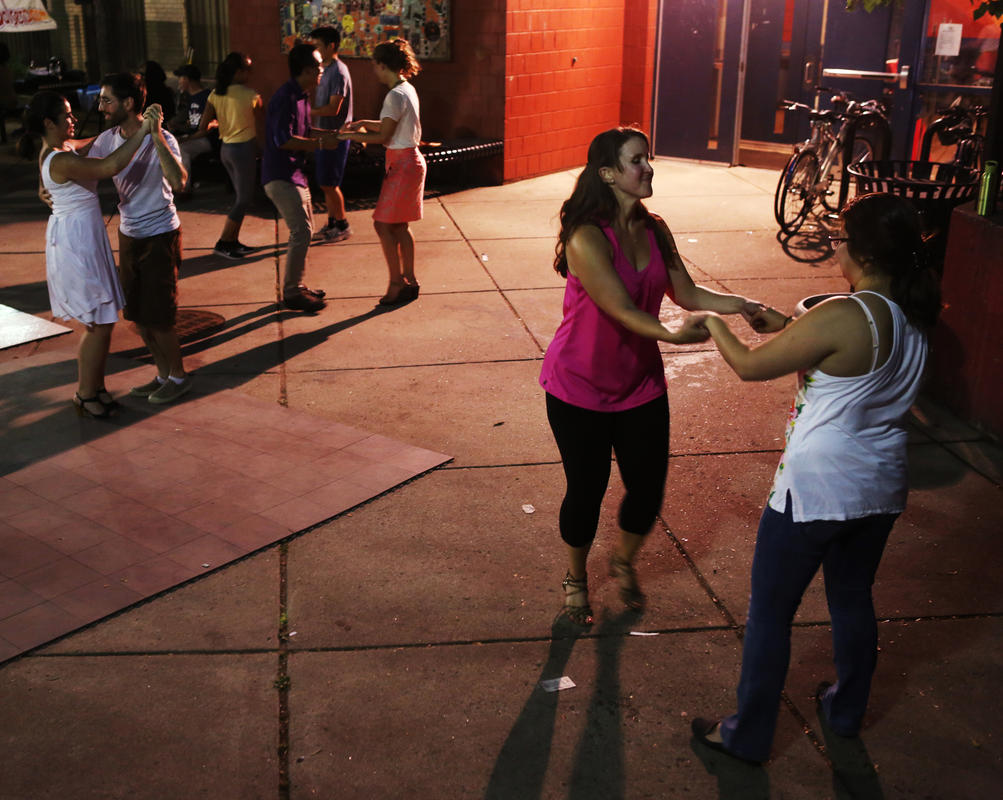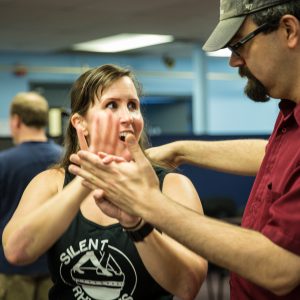
Taking the Lead: Finding Acceptance On and Off the Dance Floor
By: Kerry Thompson, Executive Director for Silent Rhythms, Inc.
Like most female dancers, I began my journey as a dancer by learning how to follow. As a Deaf person, learning to dance was to disrupt the notion that a Deaf person could not learn how to dance or experience the joy of music. Fifteen years later, still Deaf but now legally blind, I am disrupting another notion – that I cannot lead.
I was hesitant to disrupt. Learning how to lead in dance was a terrifying thought for me. Just like all those years ago when I was the only Deaf dancer in class, I would once again be the outlier – the DeafBlind dancer. This time learning how to dance would be all the more challenging as I could now only see 10% of what you see. Previously, I relied on my eyesight to compensate for what I could not hear. Initially, I focused on what I could not do – hear or see – that I forgot to focus on what I could do. I had to remind myself of what I could do and that was I already could dance. I could also think creatively and come up with innovative solutions to barriers – skills that are often attributed to a good leader. So then began my journey how to lead – on and off the dance floor.
Changing Views
The first step to taking the lead was to change my own view on being a leader. Many would share their view with me that “leading” was a man’s job. With that approach in mind, I used to teach the follower’s role while asking a male dancer to teach the leader’s role as part of Silent Rhythms’ Salsa Class for the Deaf. With no hearing leaders who knew sign language, I found myself running back and forth between teaching the females in sign language and running to interpret for the males. Even when there were sign language interpreters present, it was not enough. The best way to teach someone who is Deaf or DeafBlind is to be able to understand their point of view and be able to “walk a mile” in their shoes. I told myself the solution was clear although not simple or easy – I would have to learn how to lead in order to more effectively teach the Deaf leaders in my class. I also needed to relive the experience of being a new student and the nerve-wracking feeling of learning something new.

Kerry, shows a man with Deafblindness how to lead.
“Women need to shift from thinking “I’m not ready to do that” to thinking “I want to do that- and I’ll learn by doing it.” ― Sheryl Sandberg, Lean In: Women, Work, and the Will to Lead.
When Women Lead
Why is taking the lead as a female, such an issue on the dance floor or even in society? In the business world and politics, we are seeing an unmet demand for equal opportunities and equal pay for women and for more female leaders. Some say that women themselves are at fault for not asking for more or for accepting misogynistic social norms. In my first class as a leader, my supportive dance teachers introduced me to the class and explained that I would be taking the class to learn how to lead. The response to the concept of a female being a leader was mixed – supportive, confusion, and a bit of awe. A few were curious about my sexuality. Was I queer? No, I simply wanted to be a better dance teacher. The question of sexuality often comes up when women try to take the lead (and for men if they try to learn how to follow). Borrowing from another quote from Sheryl Sandberg, “in the future, there will be no female leaders, just leaders.”
But, When Women with Disabilities Lead
Let’s go back to my first class as a leader when my dance teachers introduced me – a female learning to lead. The dance teachers shared that I was also Deaf and…wait for it…. Blind. That led to an even stronger response of support, confusion, and awe. Confusion was the one that probably stood out the most, mixed in with a little fear. The guys were somewhat relieved that they would not have to dance with me while the females were a bit hesitant as they were not sure how this would work. To be honest, neither was I. Once the class saw that I could already dance and according to most followers, was a better lead than the guys, we all managed to fall into a rhythm. This acceptance was initially limited to my fellow classmates and did not yet extend to the dance floor. I actually had not planned to use my new skills as a leader on the dance floor, only to pass along my knowledge to the Deaf and DeafBlind males in Silent Rhythms’ classes. But learning to lead solved a few other challenges for me. For example, there are usually far more women than men at a dance social and I used to have to wait my turn for a leader to ask me to dance, now I can dance with anyone no matter what the gender ratio may be. Second, many men were afraid to ask me to dance due to my disabilities and those I asked to dance would pass as they did not want to dance with someone like me. Women tend to be a bit more open-minded and accepted my invitation to dance. Third, it’s actually easier for me to lead than to follow as a visually impaired dancer as I am in control of the dance and can decide the next move.
Taking the lead as a dancer has become a parallel journey for me as I also take the lead in society as a woman with a disability. As women fight for acceptance as a leader in general, women with disabilities are at an even greater disadvantage than their sisters without disabilities. Even men with disabilities are deemed a more “qualified” leader than women with disabilities.
Leading Off the Dance Floor
When I first founded Silent Rhythms in 2008, it was with the purpose of providing accessible dance classes for people with disabilities, starting with a class teaching those who are Deaf. I saw that Silent Rhythms had the potential to be more than a dance class, it could be a catalyst for real change. New programs were added to the Deaf dance classes – workshops to teach dancers how to demonstrate the technique to those with disabilities, teaching joint dance and sign language classes for dancers to create a more inclusive community, to promote the inclusion of the most marginalized people in society such as those who are DeafBlind, and to lend inclusion expertise to organizations, museums, dance companies, and theatres, In 2017, Silent Rhythms, became a 501c3, a nonprofit that focuses on supporting inclusion in the arts for people with disabilities while also using the arts to support inclusion of people with disabilities in society. Silent Rhythms, Inc.’s work has been widely recognized and featured in publications such as the Boston Globe, the Boston Herald, and ABC News’ More In Common.
Once Silent Rhythms became a nonprofit, I found myself in a new leadership role – being responsible for legal compliance, fundraising, financial management, and program development. In this role, I found that I had to once again prove myself capable as a leader when faced with those who were uncomfortable by the idea that a person with a disability could lead. When I attend arts conferences or donor events, many assume that I am there in a small role as a poster child for an organization’s attempt to “include people with disabilities” and not as their equal.
So while learning to lead began with a (dance) step, my journey to becoming a leader became a much more profound one. Madeleine Albright, the first female U.S. Secretary of State, said that females need to learn how to interrupt in order to have their say but I have learned that more importantly, I needed to learn how to disrupt.
Consider being part of empowering people with disabilities to take the lead, make a tax-deductible donation to Silent Rhythms, Inc.
DONATE